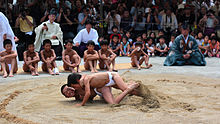Kamigamo Shrine
| Kamigamo Shrine 上賀茂神社 | |
|---|---|
 | |
| Religion | |
| Affiliation | Shinto |
| Deity | Kamowakeikazuchinomikoto |
| Festival | Aoi Matsuri (Kamo no Matsuri; May 15th) |
| Type | Shikinaisha Twenty-Two Shrines Yamashiro no Kuni ichinomiya Former kanpeitaisha Chokusaisha Beppyo jinja |
| Location | |
| Location | 339 Kamigamomotoyama, Kita-ku, Kyoto, Kyoto Prefecture |
| Geographic coordinates | 35°03′37″N 135°45′10″E / 35.06028°N 135.75278°E |
| Architecture | |
| Style | Sangensya-Nagare-zukuri |
| Date established | 678 |
| Website | |
| www | |
Kamigamo Shrine (上賀茂神社, Kamigamo Jinja) is an important Shinto sanctuary on the banks of the Kamo River in north Kyoto, first founded in 678.[1] Its formal name is the Kamo-wakeikazuchi Shrine (賀茂別雷神社, Kamo-wakeikazuchi jinja).[2]
It is one of the oldest Shinto shrines in Japan and one of the seventeen Historic Monuments of Ancient Kyoto which have been designated by UNESCO as a World Heritage Site. The term Kamo-jinja in Japanese is a general reference to Shimogamo Shrine and Kamigamo Shrine, the traditionally linked Kamo shrines of Kyoto.[3] The Kamo-jinja serve the function of protecting Kyoto from malign influences.[4]
The jinja name identifies the Kamo family of kami or deities who are venerated. The name also refers to the ambit of shrine's nearby woods, which are vestiges of the primeval forest of Tadasu no Mori. In addition, the shrine name references the area's early inhabitants, the Kamo clan, many of whom continue to live near the shrine their ancestors traditionally served.[5]
Kamogamo Shrine is dedicated to the veneration of Kamo Wake-ikazuchi, the kami of thunder.
History
[edit]

The shrine became the object of Imperial patronage during the early Heian period.[6]
Records from the reign of Emperor Heizei (806-809) mention that Kamo-mioya jinja was amongst a select number of establishments which had been granted a divine seal for use on documents. The seal would have been enshrined in its own unique mikoshi (Oshite jinja). This granting of a special seal and the practices associated with its use and preservation conformed to a pattern established by Emperor Kōnin (770–781) in 778 (Hōki 9).[7]
In 965, Emperor Murakami ordered that Imperial messengers were sent to report important events to Japan's guardian kami, including Kamo Wake-ikazuchi.[8]
Kamigamo, along with the Shimogamo Shrine, was designated as one of two chief Shinto shrines (ichinomiya) for the former Yamashiro Province.[9]
From 1871 through 1946, Kamigamo was officially designated one of the Kanpei-taisha (官幣大社), meaning that it stood in the first rank of government supported shrines.[10]
Imperial visits
[edit]- 794 (Enryaku 13): Emperor Kanmu came as part of a grand progress.[11]
- 942 (Tengyō 5, 29th day of the 4th month): Emperor Suzaku visited to offer thanks for restoration of peace.[11]
- 979 (Tengen 2, 10th day of the 10th month): Emperor En'yū decided that an Imperial visit Hachiman at Iwashimizu Shrine should be paired with a visit to Kamo.[12]
- 1711 (Hōei 8): Emperor Nakamikado took refuge in the Hosodono when the palace had become uninhabitable.[13]
Structures
[edit]The jinja is famous for its haiden (worship hall), rebuilt in 1628-1629 (Kan'ei 6).
A number of priests' residences are situated on its grounds, and one, the Nishimura House, is open to the public.
Gallery
[edit]-
Geheiden
-
Nara-no-ogawa
-
Kita-shinsenjo
-
Tatesuna & Saiden
-
Hashiden
-
Vestige of primeval forest
See also
[edit]- List of Shinto shrines
- Modern system of ranked Shinto Shrines
- Twenty-Two Shrines
- Yurihonjo hinakaido, an annual traditional doll display festival held in part of the shrine
Notes
[edit]- ^ Kyoto Prefectural Government Tourism Division: Kamigamo Archived 2009-08-28 at the Wayback Machine; Iwao, Seiichi et al. (2002). Dictionnaire historique du Japon, p. 1712.
- ^ Richard, Ponsonby-Fane. (1964) Visiting Famous Shrines in Japan, pp. 119-175.
- ^ Terry, Philip. (1914). Terry's Japanese empire, p. 479.
- ^ Miyazaki, Makoto. "Lens on Japan: Defending Heiankyo from Demons," Archived 2011-03-21 at the Wayback Machine Daily Yomiuri. December 20, 2005.
- ^ Nelson, John K. (2000). Enduring Identities: The Guise of Shinto in Contemporary Japan, pp. 92-99.
- ^ Breen, John et al. (2000). Shinto in History: Ways of the Kami, pp. 74–75.
- ^ Ponsonby-Fane, Richard. (1963). The Vicissitudes of Shinto, p. 206.
- ^ Ponsonby-Fane. Studies in Shinto and Shrines, pp. 116–117.
- ^ "Nationwide List of Ichinomiya", p. 1. Archived 2013-05-17 at the Wayback Machine; retrieved 2011-08-010
- ^ Ponsonby-Fane, Richard. (1959). The Imperial House of Japan, p. 124.
- ^ a b Ponsonby-Fane, Richard. (1964). Visiting Famous Shrines of Japan, pp. 47, 131.
- ^ Ponsonby-Fane, Visiting, pp. 48, 131.
- ^ Ponsonby-Fane, Visiting, p. 132.
References
[edit]- Breen, John and Mark Teeuwen. (2000). Shinto in History: Ways of the Kami. Honolulu: University of Hawaii Press. ISBN 978-0-8248-2363-4
- Iwao, Seiichi, Teizō Iyanaga, Susumu Ishii, Shōichirō Yoshida, et al. (2002). Dictionnaire historique du Japon. Paris: Maisonneuve & Larose. ISBN 978-2-7068-1632-1; OCLC 51096469
- Nelson, John K. (2000). Enduring Identities: The Guise of Shinto in Contemporary Japan. Honolulu: University of Hawaii Press. ISBN 978-0-8248-2259-0
- Ponsonby-Fane, Richard. (1959). The Imperial House of Japan. Kyoto: Ponsonby Memorial Society. OCLC 194887
- ____________. (1962). Studies in Shinto and Shrines. Kyoto: Ponsonby Memorial Society. OCLC 399449
- ____________. (1963). Vicissitudes of Shinto. Kyoto: Ponsonby Memorial Society. OCLC 36655
- ____________. (1964). Visiting Famous Shrines in Japan. Kyoto: Ponsonby-Fane Memorial Society. OCLC 1030156
External links
[edit]- Kamigamo Shrine website Archived 2017-10-23 at the Wayback Machine
- National Treasures of Japan
- Important Cultural Properties of Japan
- Shinto shrines in Kyoto
- World Heritage Sites in Japan
- Historic Sites of Japan
- 7th-century establishments in Japan
- 678 establishments
- Religious buildings and structures completed in the 670s
- 7th-century Shinto shrines
- Beppyo shrines
- Kanpei Taisha
- Myōjin Taisha
- Twenty-Two Shrines
- Chokusaisha
- Kamo clan
- Nagare-zukuri










